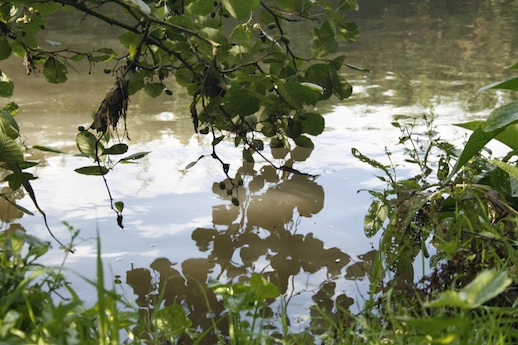Words & pictures by Melissa Harrison.
Every August I come to the Shreen to write, and every year, like the river, I am both different and the same. Friends of mine have a house with a garden that runs down to the riverbank, and for two weeks, while they are on holiday, their garden, set in a broad loop of the river, is my domain. My London life is set aside and I can immerse myself totally in work. Life here moves more slowly, or seems to; and I can more easily detect the deeper currents of my imagination.
The Shreen is a tributary of the Stour, and with the Loddon forms a trio of sinuous rivers that meet in this sprawling north Dorset town. Consequently Gillingham is a place rich in riverbanks; many houses have frontages or river views, many are liable to flooding, and to walk around the town is to cross and re-cross running water. There were once corn and hemp mills, and a rope-walk; the rivers were also essential to the brick, soap and glue factories that used to thrive here. Some areas, like Peacemarsh, Cold Harbour and Colesbrook, still give away their watery origins in their names.
As it runs through the modern town the Shreen takes many forms. ‘My’ stretch of riverbank, at the end of a large garden that includes lawns, a vegetable patch and an orchard, is left relatively wild. A child’s swing hangs from a huge willow, and there’s a little jetty, but the bank itself is a glorious tangle of nettles and long, lush grass, its soft and giving soil dotted with mole hills. The river here is shallow and shaded by trees; on the far bank, here and there, are dark holes just above the waterline. As I peered at them hopefully one afternoon a kingfisher unzipped the air at exactly my eye level and then perched on a branch over the water, calling shrilly, for a few heart stopping seconds.
Upstream, where I walk the family’s dog across floodplains dotted with sheep, the gardens on the opposite bank have waterside terraces, manicured lawns and complicated bird feeding stations from which starlings – and sometimes mallards – explode as I pass. The banks here are dressed with water forget-me-nots and flags. I meet a fellow dog-walker – barefoot amid the sheep shit and thistles – who tells me she has just been watching a water vole busy among the weeds at the end of one garden. “There’s an otter, too,” she tells me. “We set up a webcam.” I ask her if she got a good picture. “Only its bottom,” she admits.
It’s hardly surprising: the slow-moving Shreen is full of grayling, and word has it the man next door landed a brown trout last year with a worm from his garden. I sit cross-legged on the jetty one warm evening with a glass of wine and watch the fish rise, dimpling the water’s surface and shattering the still reflections of the leaves above. As darkness falls, bats flicker around me, creatures from a different element competing with the fish beneath the surface for flies.
Even the pets around here seem semi-aquatic. In the mornings, out with the dog, I often see cats crouching amid the dense riverside vegetation at the far end of gardens, invisible to their owners indoors but exposed to anyone on the opposite bank. They are hoping for ducklings or (worryingly) water voles, and I wish them no success. All the local mutts (including the one I walk) seem to insist on going in for a dip. I meet a man whose border collie quarters the Shreen for lost balls: “She knows all the places where they catch,” he tells me, “you know, where there’s a bend, or some branches. She always fishes them out.”
Past the back gardens the Shreen’s channel disappears between impenetrable stands of tow-headed thistles or opens out into shallow mires whose churned-up banks speak of thirsty sheep. The water betony is buzzing with wasps, and here and there a buddleia dangles its purple fag-ash over the river, attended by fluttering clouds of tortoiseshells and cabbage whites and peacocks.
I wrote and revised large parts of my novel, Clay, by this river, and now I am here to complete my second. Four visits; four Augusts: the vegetable garden always gravid with pumpkins and courgettes that become marrows overnight, but the fields around the house fading to sandy grass and the hedgerows studded with bitter blue sloes. It is one of the year’s tipping points, and a time of change for me, too, as I bring the first flourishing of a book into something like maturity – or so I hope.
At the start of each writing day I walk the dog beside the Shreen Water, and at its close I go down to the end of the garden by myself to watch it slip silently past. As dusk falls the trees by the river fill with roosting songbirds and next-door’s chickens quieten in the coop. I know that the August sky above is hosting the Perseids somewhere beyond the equinoctial clouds, but in the dimpled surface of the water by the jetty I can see only my own, slow-fracturing silhouette.
